After breakfast the first course of action was to buy a Tokyo Metro ticket. As I walked to Skinjuku station I snapped the following photo of the Tokyo Metropolitan Government Office.

Now I had done some
research on using the subway in Tokyo and the first thing I needed to acquire was a
PASMO card. This would allow me to save an amount on Yen that I could use when I travelled simply by swiping the
PASMO card. This would be very handy since at this stage I wasn't exactly sure where I was going.
When I arrived Shinjuku station there were plenty of people but not as many as I expected. This was most likely because it was a weekend. I headed to the first bank of ticket machines I could find but couldn't find any that dispensed the
PASMO card. Hmmm. I then headed off to be closer to actual platform and viola, here was the machine I was after. The ticket has a button that allows you to display the commands in English so I proceeded to obtain a card and added 4,000 Yen to the card to cover my subway travels. With that complete I headed to the platform for the Marunouchu Line.

The
Tokyo Metro is really pretty easy to use. You simply locate the line on which you wish to travel (it is colour coded). You then determine the station you are at and the station you wish to get to. Each station has a number. Simply go to the platform that will take you in the right direction and hop on the train. Most stations have the English displayed underneath the Japanese and most of the signs again have English displayed underneath the Japanese.
My first stop was going to be Tokyo station which would bring me out near the Imperial Palace. After exiting the Metro station it took me a few moments to obtain my bearings (as it always seems to) and from there I proceeded to the Palace.
The first thing that struck me about the Palace is how impeccable maintained it is. All the grass is newly mowed and the whole place is immaculate.


The most famous landmark of the Palace is the Nijubashi, a double arched stone bridge, east of the Palace. Complete in 1888 and is the Palace's main entrance.





From there I decided that I'd walk around the Palace grounds. So I headed south.


As I started walking around the grounds I noticed a pointy brown building that I had seen in my guide book (in the centre of the above picture) so I decided to head over to have a look since it wasn't too far away.


The building is actually the Japanese Diet or parliament building. I continued back towards the boundary of the Palace grounds.

Along the way I snapped the above picture of the Japanese nation theatre (I think). What it illustrates is the fact that I thought Tokyo would simply be a concrete jungle but in fact there is a surprising amount of flora in a city this large.

The moat runs around most of the Palace grounds. On the opposite side of the road I found the very impressive British Embassy.


By now I was reaching the northern side of the Palace grounds. I decided to head across the road and visit Kitanomaru park because I wanted to see the Nippon Budokan.


The Budokan is where the Judo competition was held during the 1964 Tokyo Olympics. Apparently these days it is mainly used for rock concerts but there was some sort of judo tournament happening when I was there.
I headed back towards the Palace grounds again passing the Science and Technology museum.
I now entered the East Garden of the Imperial Palace which is open to the public. Interestingly they give you a domino like ticket that you have to return when you leave this part of the Palace.



Once again you can see how immaculately the grounds are maintained.




I headed out of the Eastern Gardens through another magnificent gate.

I now headed to the south east corner of the Palace park and came across the following statue.
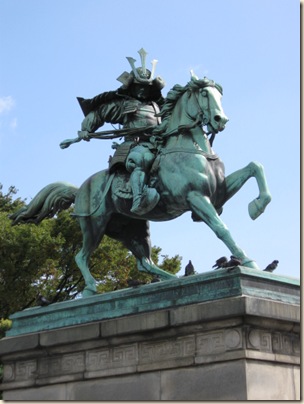
From here I decided to head back towards the centre of Tokyo to Ginza.
 Since it was a weekend (actually a 3 day weekend as I would find out later) they had closed the main street (Chou-dori) and had places to dine as well as allowing people a place to while away a weekend.
Since it was a weekend (actually a 3 day weekend as I would find out later) they had closed the main street (Chou-dori) and had places to dine as well as allowing people a place to while away a weekend.

A bit further down Chou-dori I came across the San’ai building, a very famous landmark in Tokyo. It looks more impressive at night and I promised myself that I would return one night to get some more shots.
 As you down the streets you get a better idea of the number of people wandering around, and don’t forget this is a weekend!
As you down the streets you get a better idea of the number of people wandering around, and don’t forget this is a weekend!
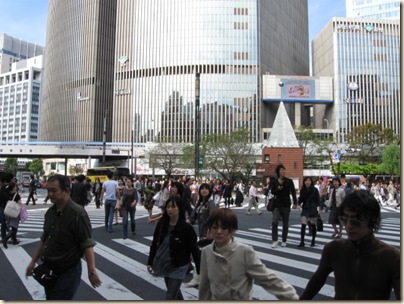 Another good example is the above shot of the crossing at Harumi-dori and Sotobori-dori (near the Sony Showroom). Basically there are 5 corners and a crossing from each to the other side. When the lights say walk, everyone walks and the tarmac disappears into a sea of people.
Another good example is the above shot of the crossing at Harumi-dori and Sotobori-dori (near the Sony Showroom). Basically there are 5 corners and a crossing from each to the other side. When the lights say walk, everyone walks and the tarmac disappears into a sea of people.
I walked around a bit more heading east and came across the Kabuki-za theatre.
 I vowed to return to Ginza at night to get a better idea of what the place was like after dark but for now I headed to the subway to grab a train north to Ueno Park.
I vowed to return to Ginza at night to get a better idea of what the place was like after dark but for now I headed to the subway to grab a train north to Ueno Park.
After hopping off the subway I entered Ueno Park. I headed to the southern end of the park and to the Saigo Takamori statue.
 Saigo after the leader of the Meiji forces instigated the Satsuma rebellion against the Emperor in 1877. He killed himself when this failed but was posthumously pardoned.
Saigo after the leader of the Meiji forces instigated the Satsuma rebellion against the Emperor in 1877. He killed himself when this failed but was posthumously pardoned.
 Just besides Saigo’s statue is the Tomb of the Shogi Tai. It is dedicated to the many samurai who died in the battle of Ueno in 1868.
Just besides Saigo’s statue is the Tomb of the Shogi Tai. It is dedicated to the many samurai who died in the battle of Ueno in 1868.
 From there I walked north to the Kiyo-mizu hall which was part of the original Kanei-ji temple.
From there I walked north to the Kiyo-mizu hall which was part of the original Kanei-ji temple.
 A little further north is this pagoda which is over five stories. It dates from the 17th century and stands in the grounds of Ueno zoo which contains giant pandas.
A little further north is this pagoda which is over five stories. It dates from the 17th century and stands in the grounds of Ueno zoo which contains giant pandas.
 A long the path to the west are all these lanterns.
A long the path to the west are all these lanterns.
 At the end of the path is the Tosho-gu shrine.
At the end of the path is the Tosho-gu shrine.
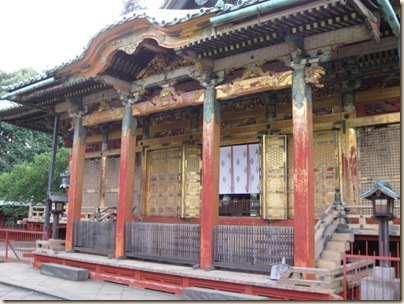 It cost me about 200 Yen to go inside the Shrine and to do so you must remove your shoes. There is not a lot inside to see but it is still amazing to think how old the structure is.
It cost me about 200 Yen to go inside the Shrine and to do so you must remove your shoes. There is not a lot inside to see but it is still amazing to think how old the structure is.
From here I headed north past the Tokyo Metropolitan Art Museum and towards the Tokyo National Museum.
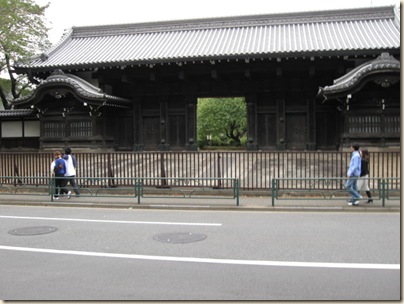 A bit further along from the gate in the above picture is the actual entrance. Being a weekend there were plenty of people already going in so as I was starting to feel a bit tired from all the walking I had done I decided to give the museum a miss and return during a weekday when hopefully there wasn’t as many people.
A bit further along from the gate in the above picture is the actual entrance. Being a weekend there were plenty of people already going in so as I was starting to feel a bit tired from all the walking I had done I decided to give the museum a miss and return during a weekday when hopefully there wasn’t as many people.
As there was still some time left in the day I had a look through my guide book to see what else was close by. I decided to head east and visit the Senso-ji temple. I figured that being a weekend there wouldn’t be too many people at a temple.
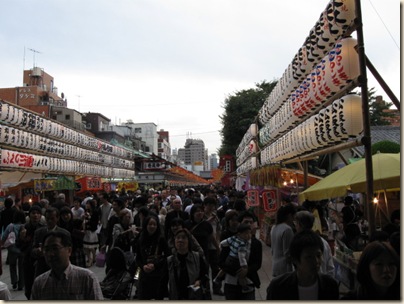


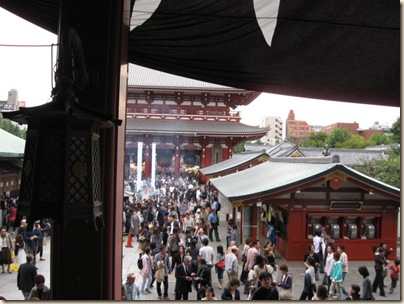




 As you can see from most of the above shots I couldn’t be more wrong! Talk about people! When you enter the Shrine through the initial gate (last photo above) you walk down a long path with shops on either side (first shot above). This is were I got my first true experience of crowds in Tokyo. It wasn’t an issue after overcoming the initial shock. This is something you have to get used to in Tokyo – people.
As you can see from most of the above shots I couldn’t be more wrong! Talk about people! When you enter the Shrine through the initial gate (last photo above) you walk down a long path with shops on either side (first shot above). This is were I got my first true experience of crowds in Tokyo. It wasn’t an issue after overcoming the initial shock. This is something you have to get used to in Tokyo – people.
After walking around the Shrine for a while I decided it was time to head back to my hotel and get ready for my trip to Mt Fuji tomorrow.




























 Now I had done some
Now I had done some  The
The 








 As I started walking around the grounds I noticed a pointy brown building that I had seen in my guide book (in the centre of the above picture) so I decided to head over to have a look since it wasn't too far away.
As I started walking around the grounds I noticed a pointy brown building that I had seen in my guide book (in the centre of the above picture) so I decided to head over to have a look since it wasn't too far away.


 The moat runs around most of the Palace grounds. On the opposite side of the road I found the very impressive British Embassy.
The moat runs around most of the Palace grounds. On the opposite side of the road I found the very impressive British Embassy. 
 By now I was reaching the northern side of the Palace grounds. I decided to head across the road and visit Kitanomaru park because I wanted to see the Nippon Budokan.
By now I was reaching the northern side of the Palace grounds. I decided to head across the road and visit Kitanomaru park because I wanted to see the Nippon Budokan. 



 Once again you can see how immaculately the grounds are maintained.
Once again you can see how immaculately the grounds are maintained. 


 I headed out of the Eastern Gardens through another magnificent gate.
I headed out of the Eastern Gardens through another magnificent gate. 

 After a little more walking I was back where I started looking at the Nijubashi bridge.
After a little more walking I was back where I started looking at the Nijubashi bridge.






















